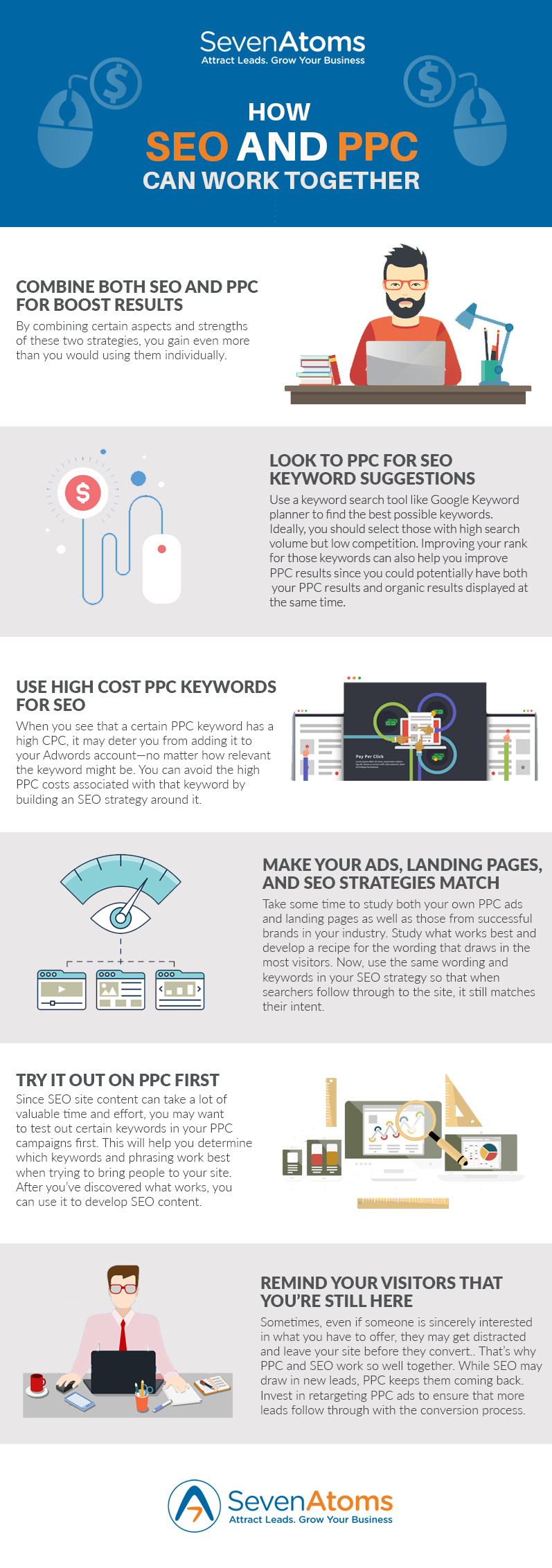Marketers often speak about Search Engine Optimization (SEO) and Pay-Per-Click (PPC) ads as if they are at odds with one another. However, that isn’t the case. Like most good things, SEO strategy and PPC strategy can work together quite nicely, and a multi-channel approach to search engine marketing may be just what you need to take your lead generation to the next level.
Take a look at our infographic for a brief overview of how these two strategies work well in tandem. Then, read the content below to learn how you can mix your own SEO and PPC strategies for amazing results.

Embed this infographic on your site
Why You Need a Multi-Channel Strategy
Free organic web traffic is what every marketer and business owner dreams of. By creating valuable and consistent content that emphasizes relevant SEO keywords and phrases, businesses can work to improve their ranking on the search engine results page (SERP), which can improve click-through rates (CTRs). In fact, the first result on the SERP typically gets a 30% CTR on desktop and a 24.4% CTR on mobile.
However, there are a number of factors that go into ranking, and there is no way to guarantee that your brand appears in the top search spot every time. What’s more is that if you don’t appear in the top five spots, there is a good chance that the user won’t be visiting your website. This is where PPC ads come in handy.
PPC ads on Google help brands get more consistent traffic. These ads appear in the sponsored results portion of Google, which has been slowly taking over more space on the SERP. When it comes to CTRs, these pay-per-click ads have got you covered. One survey shows that paid search ads beat organic clicks for keywords with high commercial intent with about 64.6% of Google search users will click on a Google Ads when they want to purchase an item online.
The truth is that SEO and PPC work best when used together. Not only will an integrated strategy help you increase visibility in the search engines, but the data that you collect from both strategies will help you make smarter decisions when campaign planning.
How to Get Your SEO Strategy and PPC Strategy to Work Together

Now that you have a better understanding of why a multi-channel approach that includes both an SEO strategy and a PPC strategy is vital to reaching your marketing goals, it is time to talk about how you can best maximize the benefits of each. Here are some tips for getting your SEO and PPC strategies to work together for optimal results:
1. Use real-time keyword data from your PPC campaigns to inform your SEO strategy
The data that you collect from your PPC campaigns is useful in planning your SEO strategy. SEO takes a lot of time and effort to plan and implement. Though search engine optimization strategies can be effective and worthwhile, it often takes a long time to start seeing results, sometimes four to six months.
Why not test out your keywords on a shorter PPC campaign first? PPC ad campaigns provide quicker results, which can help you determine which keywords are worth pursuing in your SEO strategy. Start by using a reliable keyword search tool, and prioritize the keywords based on search volume and keyword difficulty. Once you have had a chance to test out your keywords in a PPC campaign, choose those that perform well to include in your SEO strategy. Ultimately, your SEO strategy will help improve PPC campaign results as users may start to see both PPC and SEO results when searching for your keyword.

For example, let’s take a look at the screenshot above. We want to choose relevant long-tail keywords with higher search volume and lower competition. Based on the data we see in Google Keyword Planner, the best option available appears to be “search engine marketing.” Our next step would be to implement this keyword in our PPC campaign, monitor its success, and then choose whether or not to apply it to our SEO strategy. Ideally, it is best to follow this process with more than just one keyword so that you have more options to compare.
In order to make sure that you’re using the best keywords, try using AHREFS. This phenomenal tool will provide more accurate information on:
Keyword difficulty – A score that estimates how hard it would be to rank on the first SERP for a specific keyword. AHREFS bases this off the number of backlinks that the current top search results have.
Clicks – This metric reflects the total number of clicks on the search results that people perform per month while searching for that keyword (both paid and organic).
Relevant Search Suggestions – Instead of going through Google’s autocomplete searches yourself, you can use AHREFS. It will provide you with a list of keyword ideas, showing you all the relevant suggested search queries from “autocomplete.”

AHREFS is a fantastic tool, but there are also many excellent AHREFS alternatives. Find one you like!
2. Target expensive PPC keywords in your SEO strategy
You may find that certain keywords that you would like to use in your PPC campaigns are quite expensive to bid on, especially if your competitors are also bidding heavily on these terms. When you have high Cost-Per-Click (CPC) rates on the keywords you would like to target in your PPC campaigns, use them in your organic SEO campaign instead. Rather than paying for expensive PPC keywords, you can work to target those keywords in your content.

Take a look at the screenshot above. The keyword “internet marketing business” is a great keyword for us to try. However, its suggested bid price is a whopping $64.53. This is a prime example of a keyword that would be better to use in an SEO campaign than in a PPC campaign.
By building your content strategy around money-making search terms, you can work to capture more organic traffic from the expensive keywords. This is a great strategy for businesses who have limited PPC ad budget to target expensive keywords using content and SEO. By focusing your organic, SEO-driven content on these terms, you can work to increase visibility without breaking the bank.
3. Use your SEO strategy and PPC strategy to bring back visitors and leads

There is a good chance that you have put a significant amount of effort into your SEO campaigns. However, it is inevitable that some visitors will leave your page without making a purchase. You can take advantage of all the hard work you’ve already done to get that initial traffic by retargeting these visitors in your PPC ads. Google offers the remarketing list for search ads (RLSA), which helps you bring some of those visitors back to your website through Google PPC ads.
Taking advantage of RLSA in Google AdWords is an effective way to get the most out of both your SEO and PPC strategies. Here are just a few ways you can use RLSA to reach back out to your visitors and boost conversions:
-
Use retargeting with your shopping campaigns
You can use RLSA in your shopping campaigns to help improve conversions and increase overall sales.
-
Target audiences that are most likely to convert again
Consider those who have placed items in their shopping cart but left without purchasing. Cart abandoners may be more likely to make another purchase than those who have just visited your site.

-
Isolate your audience by device
Use retargeting to reach back out to those visitors who used their mobile device to view your site. Mobile-only campaigns can often offer better performance than desktop.
Conclusion
Though this is by no means a comprehensive list of all the ways that your SEO strategy and PPC strategy can work together to increase leads and improve conversions, it does provide a starting point. Managing the data of short-tail and long-tail keywords and combining those two strategies can be challenging at scale. You can refer to this step-by-step guide.









